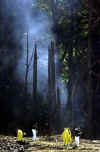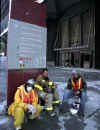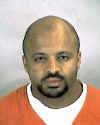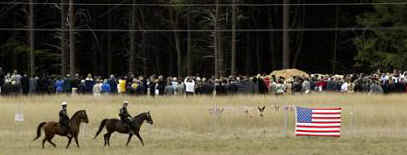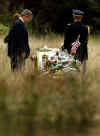| The
Story of Flight 93 The Flight of United Airlines Flight 93 is an Incredible Story of Courage and Heroism from the Morning of September 11th, 2001. ©September11News.com / Images © AP or Reuters |
| Flight
93 Heroes & Mysteries Editor's Comments ©September11News.com There is little doubt that the passengers on Flight 93 became aware that their hijacked plane was likely to be used as a terrorist's weapon. The numerous heart-wrenching, last-minute calls are evidence of the passenger's knowledge of the hijacker's intentions and the subsequent passenger plan to overthrow the hijackers. The courageous acts of the Flight 93 passengers represent a remarkable story of human bravery. However, there remains some lingering doubts as to the final minutes of Flight 93. Why is the FAA withholding the release of portions of the black box recordings? On December 7, 2001, on CNN's Larry King Live, several Flight 93 family members expressed their frustration at attempts to hear the unreleased portions of the Flight 93 cockpit tapes. Why are there no known pictures of the Flight 93 wreckage? The only pictures available of the crash site show rescue workers peering into a crater, but there is no wreckage to be seen. 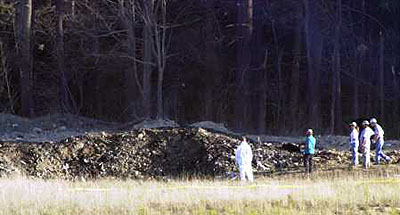 Why was the FBI still considering evidence that Flight 93 was shot down several days after the crash? And why did several eye-witnesses report seeing a fireball in the sky? Witnesses also say that pieces of the Flight 93 plane were found as far away as eight miles from the impact crater. How could parts of the plane be eight miles away if the plane was intact prior to crashing into a Pennsylvania field? The force of a high speed, nose-diving jet impacting from thousands of feet above is likely the cause of the tiny fragmented wreckage, and it is likely the wind carried the crash debris great distances. However, there remains a degree of uncertainty as to the many unanswered questions surrounding Flight 93. Questions also remain as to the intended target of the four Flight 93 hijackers. It is apparent that Washington was the likely city, but where in Washington may only be known by the dead hijackers. Speculation is the hijackers were targeting key U.S. leaders by striking at either the White House, Capitol Hill, or at Camp David. In the weeks following the hijacking of Flight 93, U.S. President George W. Bush has indicated several times that he would not hesitate in giving the orders to shoot down a commercial aircraft that was a known threat. Editor's Note: In late May, 2002 the press reported that U.S. government officials had determined that the intended target of Flight 93 was likely the White House in Washington D.C.. |
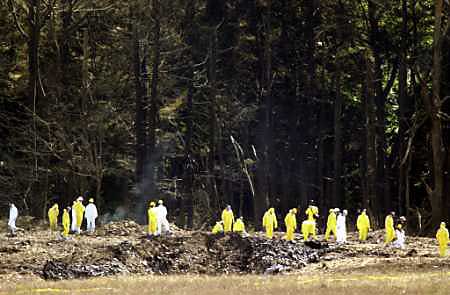 Flight 93 crater in a field in Pennsylvania. Where is the wreckage from Flight 93? |
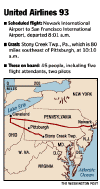 UA 93 Flight Path |
 Flight 93 Hijackers |
| The
Story of Flight 93 Reported 24 Hours After the Crash. Reported by Reuters News Service. |
| Wednesday
September 12 9:45 AM ET © Reuters Passengers on Flight 93 May Have Struggled with Hijackers SHANKSVILLE, Pa. (Reuters) - Passengers on United Airlines Flight 93 may have struggled with hijackers aboard the only one of four hijacked airliners not to hit a U.S. landmark during Tuesday's deadly assault on New York and Washington, a victim's relative said on Wednesday. Alice Hoglan of San Francisco said her 31-year-old son, Mark Bingham, called her by air-phone 15 minutes before the Boeing 757 crashed and said the plane had been taken over by three men claiming to have a bomb. "We have it from other people, another man on the aircraft who called his wife, who said he and some other passengers were hoping to get at these guys somehow,'' Hoglan, a United Airlines flight attendant who has been questioned by the FBI, told NBC's ''Today'' show. "This was the only flight of the four that did not reach its target, which they believed to be Camp David, and that gives us reason to believe that perhaps Mark was able to help save the lives of people on the ground.'' Hoglan said her conversation with her son took place soon after three other jetliners plowed into the World Trade Center in New York and the Pentagon near Washington. "The FBI asked us if we heard Mark mention anything besides a bomb. He made no mention of knives or box cutters or guns or any other weapons,'' Hoglan said. "He was forward in the aircraft, could probably be in full view of everything that was going on, probably saw what happened in the cockpit.'' United's Flight 93, bound for San Francisco from Newark, New Jersey, crashed near a strip mine at 10:06 a.m. Tuesday in a wooded section of Somerset County, about 80 miles southeast of Pittsburgh, apparently killing all 45 people on board. Eight minutes earlier, emergency officials in neighboring Westmoreland County said they received a cell phone call from another passenger who said the plane had been hijacked. The impact was so powerful that police investigators who cordoned off the site as a crime scene on Tuesday reported finding no pieces of debris larger than a phone book, and no bodies. ALL-OUT SEARCH FOR FLIGHT DATA RECORDERS Emergency officials said 150 FBI agents and a team from the National Transportation Safety Board were due on Wednesday to mount an all-out search for the aircraft's voice and flight data recorders that may have recorded what happened on board the plane. The so-called black boxes could include the voices of the alleged hijackers and provide evidence of who was flying the plane. The Washington Post reported on Wednesday that leaders of Congress were told at a briefing by the Capitol Police that the hijacked plane might have been bound for the Capitol or Camp David, the presidential retreat in Thurmont, Maryland, 85 miles southeast of the crash site. The newspaper said participants discussed a possible shoot- down of the aircraft. But the congressional leaders soon learned that the plane had already crashed. United Airlines said in a release posted on its Web site that it would advance an initial sum of $25,000 to the families of victims on board two flights involved in Tuesday's tragedy. |
| The
Story of Flight 93 Reported 50 Hours After the Crash. Reported by Reuters News Service. |
| Thursday
September 13 12:01 PM ET © Reuters FBI Does Not Rule Out Shootdown of Pennsylvania Plane SHANKSVILLE, Pa. (Reuters) - Federal investigators said on Thursday they could not rule out the possibility that a United Airlines jetliner that crashed in rural western Pennsylvania during this week's attacks on New York and the Pentagon was shot down. "We have not ruled out that,'' FBI agent Bill Crowley told a news conference when asked about reports that a U.S. fighter jet may have fired on the hijacked Boeing 757. "We haven't ruled out anything yet.'' "It's kind of a loaded question. We're basically at the infancy (of the investigation),'' Crowley added. "We haven't certainly come to that conclusion either.'' The Defense Department on Tuesday vigorously denied reports suggesting the U.S. military could have downed the hijacked flight in an effort to prevent it from reaching a target, perhaps in Washington. United Airlines Flight 93, which crashed with 45 people on board, had been en route to San Francisco from Newark, New Jersey, when it veered off course over northeastern Ohio and headed back southeast toward Pittsburgh. It crashed 80 miles southeast of that city. Pennsylvania state police officials said on Thursday debris from the plane had been found up to 8 miles away in a residential community where local media have quoted residents as speaking of a second plane in the area and burning debris falling from the sky. Crowley said authorities have not yet found the plane's crucial voice and flight data recorders, but that teams were still searching. "We've not located the black box,'' he said. ''We're confident and we will keep working on it.'' The wooded crash scene was likely to provide investigators of Tuesday's deadly airliner attacks on the World Trade Center and the Pentagon with their best chance of recovering working data recorders. The data recorders could provide an invaluable account of what occurred in the plane's cockpit after the flight turned southeast on Tuesday morning. Flight 93, which crashed near a strip mine, was the only one of four hijacked aircraft not to hit a U.S. landmark. Federal officials believe hijackers planned to crash the plane into the Camp David presidential retreat in Maryland or a target in Washington. But passengers who managed to call out on cellular phones and on-board airphones suggested they were about to thwart any such plan. "I know we're all going to die -- there's three of us who are going to do something about it,'' passenger Thomas Burnett told his wife Deena just before the crash, according to the San Francisco Chronicle. He then said, 'I love you, honey,' and that was the end of conversation,'' the Burnett family's priest, Rev. Frank Colacicco, told the newspaper. The National Transportation Safety Board was expected to conduct a flyover of the scene to verify the full extent of the debris field, which was sealed off to outsiders and the media by an army of Pennsylvania state troopers. |
| The
Story of Flight 93 Reported 57 Hours After the Crash. Reported by Reuters News Service. |
| Thursday
September 13 7:19 PM ET © Reuters / By David Morgan Flight Data Recorder Found at Pennsylvania Crash Site SHANKSVILLE, Pa. (Reuters) - A search crew found the flight data recorder on Thursday from the hijacked United Airlines plane that crashed in Pennsylvania after the attacks on the World Trade Center and the Pentagon, raising hopes of important new clues to what happened aboard the Boeing 757. The so-called black box, which was quickly transported to the National Transportation Safety Board in Washington for analysis, could shed light on what happened aboard San Francisco-bound Flight 93 before it crashed on Tuesday near a wooded area 80 miles southeast of Pittsburgh. All 45 people on board the flight lost their lives. FBI agent Bill Crowley could not say whether the data recorder was in working order. The device, discovered in the crash-impact crater at about 4:20 p.m., is designed to monitor and record the operations of in-flight systems. The voice recorder, which investigators hope will reveal conversations and events that occurred in the plane's cockpit, was still missing. We're trying to determine what happened, and this development that just occurred is going to help a lot. I think it will answer a lot of questions,'' Crowley said. Meanwhile, search crews began moving human remains from the debris field to a makeshift morgue set up in a nearby armory. Every piece of tissue that's there will be given a unique number and put into the computer,'' said Dennis Dirkmaat, a forensic anthropologist from Mercyhurst College in Erie, Pennsylvania. He was reluctant to say whether DNA analysis, dental records and fingerprints would identify everyone on board the flight, and noted that identifying the remains of the hijackers would depend on the availability of usable records. Families of the victims were expected to begin arriving soon in western Pennsylvania. Flight 93, which crashed soon after three other jetliners slammed into the World Trade Center and the Pentagon, was the only hijacked plane not to hit a U.S. landmark. That fact has brought intense speculation about what brought the plane down. Earlier this week, Pentagon officials vigorously denied initial reports that a military fighter had shot down the United Airlines jet. At a news conference on Thursday morning, Crowley told reporters that FBI investigators had not ruled out the possibility. But he later retracted the statement, saying unequivocally ``there was no military involvement in what happened here.'' Several passengers managed to telephone people on the ground to report the hijacking. Accounts described three hijackers claiming to have a bomb and a plan by passengers to overpower them. There were also reports that one man heard an explosion. If they are going to take the plane down, then we are going to have to do something,'' Deena Burnett of San Ramon, California, quoted her husband as saying during a cellular phone conversation moments before the crash. The Pennsylvania state police said debris from the crash had shown up about 8 miles away near a residential area where local media quoted some residents as seeing flaming debris from the sky. But investigators were unwilling to say whether the presence of debris in separate places evinced an explosion. State Police Major Lyle Szupinka said debris found in the residential area was small enough to have been carried by air currents after impact. In fact, much of the debris recorded at the crash site so far was said to be in pieces no larger than a briefcase. A team of archeologists were at work digging for evidence in the huge crater left by the crash, using their skills to uncover pieces of evidence from mounds of dirt. |
| -
Exactly Three Weeks After Flight 93 Crashes - The Story & Phone Calls of the Heroes of Flight 93 |
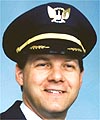 Jason Dahl (43) The Pilot on United Airlines Flight 93 |
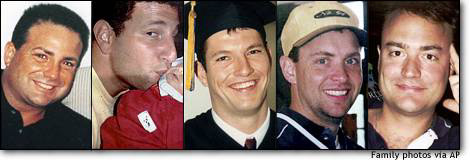 The Passengers on Flight 93 who confronted the hijackers on 9/11/2001. |
On October 2, 2001 The Seattle Times Reported the Following Story: © Seattle Times The heroes of Flight 93: Interviews with family and friends detail the courage of everyday people. By Kim Barker, Louise Kiernan, and Steve Mills © Chicago Tribune They waited, the way people wait on a plane. You can picture them spreading out inside this mostly empty flight to San Francisco, the smokestacks and cranes of the Newark skyline looming outside their windows. You can hear them working their cell phones, calling their friends, their offices. For 41 minutes they waited on the tarmac to take off. Two pilots, five flight attendants and 37 passengers. Among them, four men knew they were all waiting to die. When United Flight 93 finally took off, it began a journey that would end not in San Francisco, as planned, or smashing into some Washington target, but in an aching glory. Since Sept. 11, the story of the passengers who fought their hijackers on Flight 93 has become an icon of good thwarting evil, a story of sacrifice and courage that a nation has embraced in a time of fear and uncertainty. No one will ever know
exactly what happened on that plane. But new interviews with the family,
friends and |
| Go
to World Trade Center and Pentagon Attack Images |
Go
to World Trade Center and Pentagon Aftermath Images |

